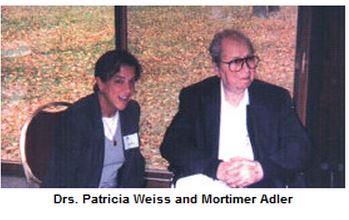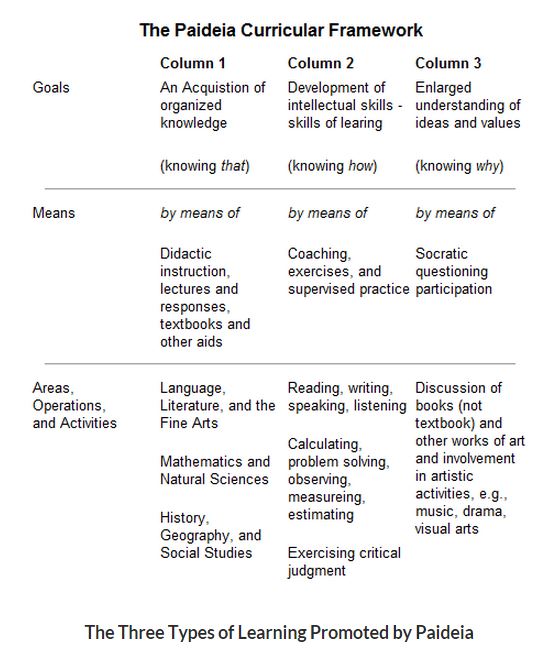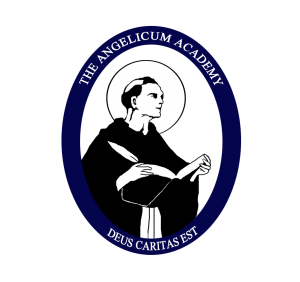THE PAIDEIA EDUCATIONAL REFORMS
Paideia History
by Patricia Weiss, Ph.D., President PGI
What is the history of Paideia?
 Paideia is a Greek word meaning the upbringing of a child. There are many different pronunciations, but the one we use is pie-day-ah. Paideia has long been used as a term for education projects. One particular use developed into a major program centered around basis principles and regular use of Socratic seminars for all students.
Paideia is a Greek word meaning the upbringing of a child. There are many different pronunciations, but the one we use is pie-day-ah. Paideia has long been used as a term for education projects. One particular use developed into a major program centered around basis principles and regular use of Socratic seminars for all students.
Between 1979 and 1985 a group of educators met with Mortimer Adler, then Chairman of the Board of Editors for Encyclopedia Britannica, to discuss education reform. They referred to themselves as the Paideia Group. Some of their concerns were the high use of lecture by teachers (85% of teacher time) as reported by John Goodlad in A Place Called School, excessive stress on coverage of material, lack of equal opportunity to education in the schools, and poor conditions for learning within the school environment created by such elements as large class size numbers.
The Paideia Group published three books: Paideia Proposal (1982), Paideia Problems and Possibilities (1983), and the Paideia Program (1984). These books sparked public interest across the country. By 1994 the Paideia Proposal was translated into 6 different languages. In response to many requests for training, Dr. Adler formed the Paideia Associates in 1985.
 The Paideia Associates designed and conducted the early training and implementation programs. The Paideia Associates formulated the Paideia Principles (below) summarizing major points in the Paideia concept of education. PGI is a national not-for-profit organization with national and international members. Mortimer Adler is the Honorary Chairman. Its purpose is to monitor and guide Paideia development, foster networking and sharing of information. In 1992, PGI instituted the stages of development and the essential elements for a Paideia school. In 1993, the board issued the certification process for trainers. PGI conducts regional workshops, an annual national conference and on site Paideia training programs.
The Paideia Associates designed and conducted the early training and implementation programs. The Paideia Associates formulated the Paideia Principles (below) summarizing major points in the Paideia concept of education. PGI is a national not-for-profit organization with national and international members. Mortimer Adler is the Honorary Chairman. Its purpose is to monitor and guide Paideia development, foster networking and sharing of information. In 1992, PGI instituted the stages of development and the essential elements for a Paideia school. In 1993, the board issued the certification process for trainers. PGI conducts regional workshops, an annual national conference and on site Paideia training programs.
Paideia Principles
That all children can learn;
That, therefore, they all deserve the same quality of schooling, not just the same quantity;
That the quality of schooling to which they are entitled is what the wisest parents would wish for their own children, the best education for the best being the best education for all;
That schooling at its best is preparation for becoming generally educated in the course of a whole lifetime, and that schools should be judged on how well they provide such preparation;
That the three callings for which schooling should prepare all Americans are (a) to earn a decent livelihood, (b) to be a good citizen of the nation and the world, and (c) to make a good life for oneself;
That the primary cause of genuine learning is the activity of the learner’s own mind, sometimes with the help of a teacher functioning as a secondary and cooperative cause;
That the three kinds of teaching that should occur in our schools are didactic teaching of subject matter, coaching that produces the skills of learning, and Socratic questioning in seminar discussion;
That the results of these three kinds of teaching should be (a) the acquisition of organized knowledge, (b) the formation of habits of skill in the use of language and mathematics, and (c) the growth of the mind’s understanding of basic ideas and issues;
That each student’s achievement of these results should be evaluated in terms of that student’s capacities and not solely related to the achievements of other students;
That the principal of a school should never be a mere administrator, but also a leading teacher who should cooperate with the faculty in planning, reforming, and reorganizing the school as an educational community;
That the principal and faculty of a school should themselves be actively engaged in learning; and,
That the desire to continue their own learning should be the prime motivation of those who dedicate their lives to the profession of teaching.
What are the results?

Educators have seen improved attendance and school climate; increases in reading, writing and communication skills; more frequent opportunities for integration of the curriculum and joint teacher planning; and more enjoyment with active learning in the seminars.
What do students say?
“Seminars are fun and allow us to express our ideas to each other and to understand the stories better.”
“I like the opportunity to think about important works and discuss them with my class.”
“I like seminars better than any other type of teaching.”
“I like to be able to continue after seminar by looking up things that I want to know about the author or his work.”
“Paideia has given me the incentive to keep on learning and to be better prepared for the future.”
Where can I go to learn more about Paideia?
Contact The Paideia Group Inc., a non-profit group founded by members of the original Paideia Group and Associates with Mortimer Adler as the Honorary Chair at Paideiapgi@aol.com, or call (919) 929-0600.
Paideia Goals – The goals are to prepare students to: earn a living; be a good citizen; be a lifelong learner.
The Three Types of Learning Promoted by Paideia
Paideia stress three types of teaching and learning:
1. Socratic teaching in seminars with primary sources (e.g., documents, essays, speeches, stories, art and math and science experiments) for understanding;
2. Coaching sessions for developments of specific skills (e.g., reading, writing, listening, analyzing, computing, and problem-solving);
3. Didactic instruction for recall of important facts and information.
The Great Ideas
The following 102 topics are the called the Great Ideas, and represent the index of the Syntopicon. Invented by Dr. Mortimer J. Adler, the Syntopicon is a topical index of Britannica’s Great Books.Comprising the first two volumes of the Great Books set, the Syntopicon allows readers to locate within the set any text that addresses that particular idea. Each Idea is accompanied by an introductory essay, and an outline which breaks down the main issues regarding the Idea that have been discussed and debated throughout history. Furthermore, there is a 42 page index to the Syntopicon itself, called the Inventory of Terms. To research a topic other than one of the 102 Great Ideas, one need only look in the Inventory of Terms to find where in the Great Ideas this topic falls. Then, referencing the outline, one finds where in the Great Books the topic is discussed. The development of the Syntopicon was a monumental task that took Dr. Adler and a staff of 90 ten years to complete. With the Syntopicon, the Great Books set becomes the single greatest reference set of the greatest body of knowledge in history.

